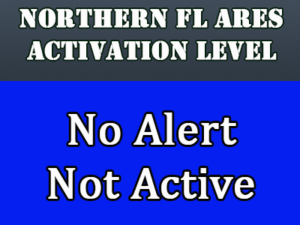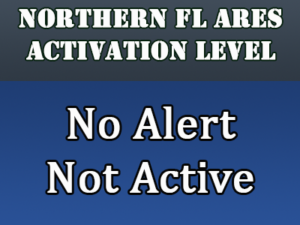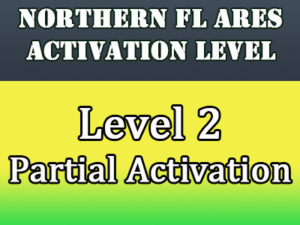
LEVEL 3 NOT ACTIVE | As of 31-August, 2023 9:00A ET/8:00A CT
Current Incident
- Current Incident- NOT ACTIVE |
- Current Status- NOT ACTIVE
- IAP (Which Includes ICS-205) – NOT ACTIVE
- Statewide Emergency Net – Emergency Net Script
- NCS Signup
Northern Florida ARES Emergency Net
In the event of an emergency, when activated by the Section Manager, the Northern Florida ARES and Northern Florida Phone Nets may combine to handle emergency related traffic. During an emergency activation, the roll-call of these nets will be suspended to facilitate emergency communications. If you are interested in being notified when emergency NCS’ are needed, please complete this signup form.
- Northern Florida ARES Emergency Net Information & Script
- Northern Florida ARES Emergency Net Training – Coming soon!
- State of Florida EOC Call Sign & Capabilities – Work in progress
About Activation Levels
Activation levels are used to communicate the status of the North FL Section ARES team. Team members should be familiar with the activation levels and be prepared to activate should the need arise.
When a disaster threatens or strikes the area, the Section Emergency Coordinator, in collaboration with Section Manager, may declare any of three levels of alert in the Northern Florida Section. Operators are strongly encouraged to review the Northern Florida Section Communications Plan for further information.

-
No Alert
- No Alert is the normal situation for amateur radio communications. This means that no state of alert or emergency exists. When a disaster strikes or threatens any Northern Florida community, affected ECs and DECs may declare any of four levels of alert of their local organization.

-
Level 3 – Monitoring
- This level will serve to notify ARES operators that their services may be needed on short notice any time in the next 48-72 hours. The alert may apply to the entire Section or to specific Districts or Counties. Omission of any area does not prohibit others from taking appropriate precautionary steps. The declaration of Level III Monitoring Phase alerts ECs, Net Managers, and other key emergency communications officials to prepare for short-notice calls. All ARES personnel in the alerted Districts or Counties should monitor designated net frequencies and keep closely in touch. Nets operating in Level III Monitoring Phase customarily run ad hoc (i.e., they are not directed.) Radio operators and officials should monitor the appropriate frequencies for information and for possible increases in or cancellation of the alert status.

-
Level 2 – Partial Activation
- This is descriptive of operational status. It is usually issued by DECs or ECs and designates net activations, staffing requests, assignments, and other such operational functions to perform specific tasks. The alert level becomes Partial Activation in a County or District when specific duty posts are staffed and become operational, and/or a net control operator opens the net. Most emergencies, even severe ones, can be handled without ever going beyond Partially Activated.

-
Level 1 – Full Activation
- This is the highest possible level of alert in an emergency communications operation. It is useful for maintaining tight control over HF circuits where heavy traffic and large numbers of stations may increase channel load on nets. When distress traffic is being handled on any emergency net or frequency, the activated level is automatically Level I Full Scale Activation and remains so until all distress traffic has been cleared. Full Scale Activation can be declared at the Section level only by the Northern Florida Section Manager or Northern Florida Section Emergency Coordinator. Full Scale Activation is declared by issuance of a Priority bulletin to be transmitted on all active net frequencies. It applies to all nets and geographic areas designated in the formal order.

-
Stand Down
- This authorizes DECs and ECs to begin the stand-down phase of the activation. Stand Down is permissive only; it does not require that operations be shut down in the specified area. It simply advises the designated DECs and/or ECs that no apparent reasons exist for continuing operation unless they have local requirements. The DEC and EC then may reduce operating hours, restrict operations or close down designated nets as the emergency passes and traffic loads subside.